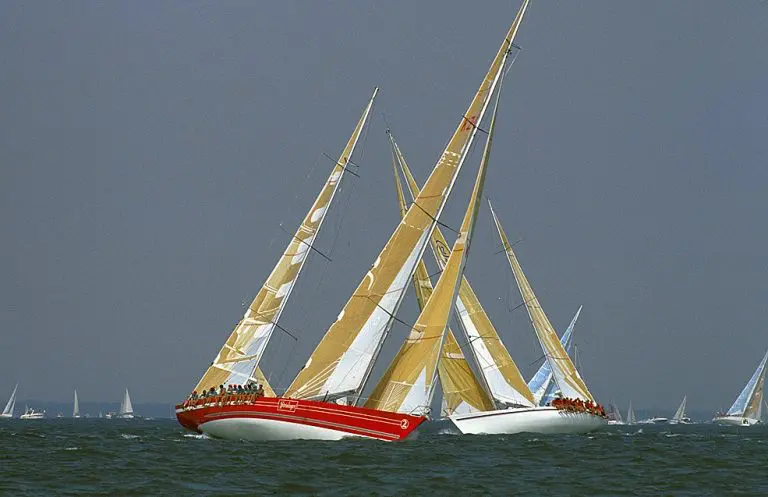“It was time at last to claim the Whitbread Trophy. After four unsuccessful attempts the victory this time was particularly sweet. ”
– Sir Peter Blake
One of the enduring qualities about Peter Blake’s sailing career was his ability first to attract excellent sponsors and second to build long term relationships and friendships with them. Sir Tom Clark is a case in point, as is Douglas Myers, the former chairman of Lion Breweries.
After the Lion campaign, with all its disappointments, Douglas Myers showed no signs of retreating. On the contrary, an ambitious project was proposed whereby Lion, under the banner of its prime export beer, Steinlager, would promote three campaigns.
Steinlager 1 was a high-tech wing-mastered trimaran aimed primarily at the two-handed round Australia Race, which was run in 1988 as part of Australia’s bicentennial celebrations. Steinlager 2 was a Whitbread maxi targeted to once and for all secure the elusive round the world title. Steinlager 3 was to be a giant multihull aimed at securing the Jules Verne Trophy for the fastest non-stop circumnavigation.
Steinlager 1 was 18m (60ft) long and nearly as wide (15.8m – 52ft). Built in carbon and kevlar, she was extremely light, but very strong. With a towering carbon-fibre wing mast, this was an out and out speed machine.
Even in relatively light winds, Steinlager 1 was capable of sailing fast enough to tow a water skier. It was all excitement in the build-up and the family shared some of it too. By now, James had been born and the Blake family of four went cruising on a very high performance multihull built for two. This was an equation that was not without frustration, especially as Blake at 6ft 4in tall had difficulty squeezing into the confined space at the best of times – let alone trying to assemble James’ cot.
For the Round Australia Race, Blake chose Mike Quilter as navigator and co-skipper. Quilter was part of the Lion crew. A former sailmaker, he brought a great depth of experience and talent to the project, as well as being thoroughly good company in any situation.
This was Blake’s coming of age. After all those years of heartbreak and endeavour, everything came together with the striking yacht that gained the affectionate nickname, Big Red.
The pair were severely tested, not to mention scared out of their wits, when they encountered fearful conditions that threatened to engulf, or capsize the trimaran. They survived the experience and won the race by five days, but Blake’s immediate post-race reaction was that he would never race in a multihull again. It was one of those ‘never again’ statements that would later be retracted.
Due to the political unrest in South Africa, the course for the 1989-90 Whitbread Race was altered to exclude Cape Town. Instead the new route went from Southampton (England), across the Atlantic to Punta del Este (Uruguay). From there it went into the Southern Ocean to Fremantle (Australia), from Fremantle to Auckland, then back to Punta del Este, up to Fort Lauderdale (USA) and, finally back to Southampton. This new route required a downwind-oriented yacht which meant that Blake had to use his yachting knowledge to make decisions about the design of the boat.
Working with designer Bruce Farr, Blake and the crew decided that the yacht would have to be longer than ever before with taller masts. After discovering that rivals Fisher & Paykel (F & P) had a very similar design with a ketch rig, Blake acted on a gut feeling and called for a last minute into a fractional rig. This meant that the boat was now even longer and had even taller masts which set Big Red apart.
The 1989-90 Whitbread Race set off from Southampton with Steinlager 2 leading the way. The boat proved its speed, knocking off a week from their estimated time and winning the first leg. The second leg proved testing for all the crews with extremely rough weather. This saw 5 people being lost overboard throughout the fleet, of which 4 were recovered alive. Despite this, Big Red came through to win the second leg by 90 minutes.
Leg 3 saw big winds and waves again and fierce competition between Steinlager and F&P with Blake coming out on top by only six minutes. The fourth leg left large crowds at Auckland and headed into snow and icebergs with Steinlager winning again, this time by 21 minutes. Leg 5 had far more steady conditions, so the crew worked hard to make the boat go as fast as possible. This ended with Steinlager crossing the finish line eight miles ahead of F & P.
The final leg proved to be dramatic, with disaster narrowly avoided when the chain plate attaching the rigging to the side of the yacht cracked. If it hadn’t been for the helmsman gybing, the chain plate would have severed and rigs would have gone over the side. A bit of Kiwi resourcefulness was used to make repairs and Steinlager 2 won by 36 minutes, winning the handicap and each of the race’s six legs.


